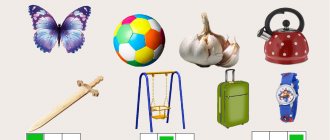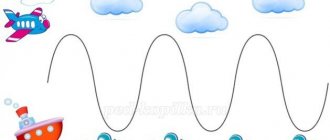Lesson summary on the topic: “Differentiation of vowels I-Y”
STATE BUDGETARY EDUCATIONAL INSTITUTION OF THE CITY OF MOSCOW "Center for Education and Sports "Moscow-98" of the Department of Sports and Tourism of the City of Moscow GBOU "TsOiS "Moscow-98" Moskomsport _______________________________________________________________________________ 110607, Moscow, Udaltsova, 40 tel.
e- mail : s [email protected] mossport . ru
LESSON SUMMARY
ON THE TOPIC OF:
“
DIFFERENTIATION OF SOUNDS S - I ”
(for children with STD in the preparatory group)
Prepared by teacher - speech therapist Elena Vladimirovna Neklyudova
Topic: “
DIFFERENTIATION OF SOUNDS S - I”
Purpose
: teach children to differentiate the vowel sounds Y - I.
Tasks:
educational:
- consolidate the concepts of “sound” and “letter”,
- consolidate visual images of sounds in children - letters (И, И),
correctional:
- develop phonemic awareness,
- develop auditory attention and memory; — improve the skill of determining the presence and position of a given sound in a word (using the example of the vowels Y - I);
- consolidate the skill of sound analysis - drawing up sound patterns of words; — consolidate the skill of inflection (using the example of the formation of plural forms of nouns.
educational:
- to develop children’s interest in activities,
- stimulate children's activity in the classroom.
Equipment:
subject pictures whose names begin with a vowel sound; subject pictures whose names contain vowels Y or I; didactic manual “Houses for Sounds”
(to determine the position of a sound in a word); symbols of words, syllables and sounds (for drawing up word diagrams), mirrors.
H o d a n i a t i i :
1. Organizational moment.
Teacher speech therapist:
: Hello guys! There are pictures on your tables.
You look at them and name the sound that starts
this word (in children’s pictures there are object pictures starting
from vowel sounds).
Those children who correctly name the first sound in the word will sit.
Teacher speech therapist:
So, you all correctly named the sounds: A. U. O. I. A. who can tell me what sounds these are? (vowels). Why are they like this
are they called? What happens in the mouth when we pronounce
vowel sounds? (children's answers).
P. The main part of the lesson.
1) Setting the goal of the lesson :
Speech therapist teacher: —
Today we will learn to distinguish the sounds “Y” - “I”, find similarities and differences in them, remember their “secrets” and “tricks”.
In addition, we will make diagrams of words. - Say the sounds “Y” - “I” in turn in front of the mirror, and say what sounds they are, how they are similar and how they differ. (children's answers). 2) Development of phonemic hearing:
a) isolating a given sound (“Y” or “I”) from a sound, syllabic and a number of words; b) repetition after the speech therapist of syllable chains consisting of consonants and vowels “Y” or “I”.
3)
Determining the presence and position of the sounds “Y” or “I” in words - the game “New Residents”
Speech therapist teacher
: We pronounce and hear sounds, and we read and read letters
we write. Today we will talk about the vowels “I” and “Y” (cards with the letters “Y” - “I” appear on the board). I will give you pictures, and you have to think about what sound “Y” or “I” is in this word and “where this sound is located (at the beginning, middle or end of the word) - “let’s put the pictures in our houses.” The didactic manual “Houses for Sounds” appears on the board
Children complete the task, find which sound (Y or I) is in the word, determine its position (they move into a house) and the number of syllables in it.
Teacher speech therapist:
- Well done! Look at the board and say: how are these sounds similar? What is the difference? What is the “trick” of the vowel sound “I”? etc. (children's answers). - Why are there no “tenants” in the house for the sound “Y” on the top “floor”? (children's answers)
4 .
Improving inflection skills - forming plural forms of nouns - ex.
“One-many” Speech therapist teacher
: - Now we will play the game “One-Many”.
I will show and name the task picture, and you will do the whole chain (for example: cat - cats - many cats) - (children's answers). pictures-tasks: rooster – roosters;
cat-cats; dog, bird, tiger, umbrella, castle, banana, apple, etc.). Teacher-
Speech therapist: - Look at the pictures on the board in which the sounds “I” and “Y” are at the end of words.
( roosters, dogs, birds, sheep, arrows, dolls, birch trees, shoes, etc.).
What can you say about these words? — How many objects are shown in the pictures: one or several? (children's answers).
— You and I “saw” and heard that the sounds “Y” and “I” are at the end of words denoting several objects.
5 Physical education minute
.
- on attention and coordination of movements.
6. Improving sound analysis skills
.
1) isolating vowels from words in order.
Teacher speech therapist:
- Guys, now we will separate vowels from words in order.
I will show and name the picture - the task, and you - only vowels in order. (for example: SHOES - U, I) Task cards: slippers, beads, skating rink, cube, cat, sofa, kiwi, wasps;
minute, street, raspberry, paper, gooseberry, pyramid, etc.) 2) compilation and analysis of word patterns.
Teacher speech therapist:
- Guys, remember what words are made of? What are syllables made of? What shapes and what colors do we use to denote words, syllables, vowels, hard consonants and soft consonants (children’s answers). Colored symbols of words, syllables and sounds, as well as task pictures, appear on the board. Children lay out and analyze the patterns of the words MAKI, FLIES, HORSES, PANAMA (how many syllables, how many vowels, how many hard consonants, how many soft consonants, how many consonants, how many sounds?, etc.
Sh. Summary of the lesson.
Teacher speech therapist:
— Today we worked with the vowel sounds “I” and “Y”. We learned a lot of interesting things about them. If the sound “I” comes after a consonant, it makes that consonant soft. Vowels can always appear in a word at the beginning, in the middle or at the end. Only the vowel sound “Y” never occurs at the beginning of words! If the sounds “I” and “Y” are at the end of a word, then this word denotes several objects. There are as many syllables in a word as there are vowels. Class is over, thank you
Publications on speech therapy
Goals and objectives:
1. To strengthen students’ ability to distinguish between vowels Y-I in oral and written speech.
2. Strengthen the ability to differentiate consonant sounds before the vowels Y-I. 3. Enrich your vocabulary with words formed by changing numbers. 4. Develop and improve the grammatical structure of speech. 5. Develop phonemic perception, sound-letter analysis of words. 6. Develop visual perception. 7. Develop gross and fine motor skills. 8. Form positive motivation for students through the use of playful and entertaining exercises. Equipment:
computer, envelopes with individual cards, sticks, three-dimensional letters.
Progress of the lesson.
Organizational moment
The long-awaited bell has been given, the lesson begins...
How to call it in one word:
sparrow, swallow, magpie, crow (birds)
boletus, russula, chanterelle (mushrooms)
Which vowels will we emphasize in these words:
AND Y
As you guessed, the topic of today's lesson: distinguishing the vowel sounds ы, и. 1. Game “Identify by touch.”
Children approach the table on which there are three-dimensional letters and, with their eyes closed, find one of the letters being studied among the letters P, N, B, M, L, Y, I. Listen to the syllables.
Tell me what vowel you hear. Listen to the syllables: we, you, would, you, dy, ly. What vowel sound did you hear? Which letter should we choose? And now other syllables: bi, vi, di, li, mi, ti. What vowel sound did you hear? Which letter should we choose? What does this depend on? Conclusion: after hard consonants there is a sound [s] (letter s), after soft consonants there is a sound [i] (letter i). Differentiation s-i in phrases. 2. Game “On the contrary”
py - pi ky-ki
you - ty now-ni we - mi dy-di 3. Task on the computer.
Fill in the missing letters in the words. R...S, M...R, S...R, K...T, R...S, M...LO, K...NO, S...RO, S...LA, R...BA, L...DA, R...TA, V... L..., M...L..., L...S... . 4. Game “One-many” with throwing the ball. For example: garden - gardens.
Goat - goats owl - owls game - games rose - roses boots - boots glass - glasses
– What sounds appeared when we changed words?
Differentiation Y-I in phrases.
5. Correct mistakes in word combinations. WHITE FLUSHES fragrant lilies of the valley SPICY CLICKS LIGHT SNOWFLAKES FRIENDLY MALISH FUN HOLIDAYS 6.
Here's Dunno's exercises.
Do it in order. Get up quickly, smile, Stretch higher, higher. Come on, straighten your shoulders, raise them, lower them. They turned to the left, to the right, Hands touched with knees. And now let’s sit down again and sit quietly. Differentiation Y-I in sentences. 7. Make up sentences.
Individual work using cards.
I'm on a hike (was - beat). I (was - beat) the drum. I rope (howled - pitched). Wolf in the forest (howled - pitched). The baby was very (nice - soapy). He washed his hands with soap (mil - washed). – After completing the task, perform a peer review. 8. Task with sticks.
Prepare 6 sticks and make a house out of them.
Arrange 2 sticks to form a flag. – Check yourself to see if you completed this task correctly. 9. Make sentences from words.
Assignments in envelopes. Write down the sentences in your notebook.
1. TANYA HAS A TEETH HURT. 2. SMOKE IS COMING FROM THE PIPE. 3. PLUMS GROW IN THE GARDEN. 4. THE CAR HAS NEW TIRES. 5. THE FOREST IS DAMP. Lesson summary. – Were you interested in the lesson? – What did you find most difficult? Homework. - Thank you for the lesson. Mazanova
E.V.
Correction of acoustic dysgraphia. Lesson notes for speech therapists / E.V. Mazanova. – 2nd ed., revised. – M.: Publishing house GNOM and D, 2007. Chistyakova
M.I. Psychogymnastics / Ed. M.I. Buyanova. – 2nd ed. – M.: Education: VLADOS, 1995.
— 05/11/2013 (22:41) Author Torbochkina Ekaterina Evgenievna
torbo4kina[@]yandex.ru


